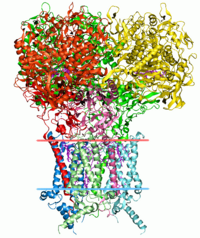
Photo from wikipedia
The analysis of evolutionary information in a protein family, such as conservation and covariation, is often linked to its structural information. Multiple sequence alignments of distant homologous sequences are used… Click to show full abstract
The analysis of evolutionary information in a protein family, such as conservation and covariation, is often linked to its structural information. Multiple sequence alignments of distant homologous sequences are used to measure evolutionary variables. Although high structural differences between proteins can be expected in such divergent alignments, most works linking evolutionary and structural information use a single structure ignoring the structural variability within protein families. The goal of this work is to elucidate the relevance of structural divergence when sequence-based measures are integrated with structural information. We found that inter-residue contacts and solvent accessibility undergo large variations in protein families. Our results show that high covariation scores tend to reveal residue contacts that are conserved in the family, instead of protein or conformer specific contacts. We also found that residue accessible surface area shows a high variability between structures of the same family. As a consequence, the mean relative solvent accessibility of multiple structures correlates better with the conservation pattern than the relative solvent accessibility of a single structure. We conclude that the use of comprehensive structural information allows a more accurate interpretation of the information computed from sequence alignments. Therefore, considering structural divergence would lead to a better understanding of protein function, dynamics, and evolution.
Journal Title: Molecular phylogenetics and evolution
Year Published: 2018
Link to full text (if available)
Share on Social Media: Sign Up to like & get
recommendations!